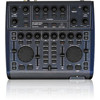Behringer B-CONTROL DEEJAY BCD2000 Manual - Page 15
Standard IEC receptacle
 |
View all Behringer B-CONTROL DEEJAY BCD2000 manuals
Add to My Manuals
Save this manual to your list of manuals |
Page 15 highlights
B-CONTROL DEEJAY BCD2000 7. AUDIO CONNECTIONS You will need a large number of cables for different applications. The illustrations below show how the connectors should be wired. Be sure to use only high-grade cables. The microphone input of the BCD2000 is electronically balanced to avoid hum problems. Of course, you can also connect unbalanced microphones to the balanced input. In this case, connect pin 1 and pin 3. 8. SPECIFICATIONS AUDIO INPUTS Microphone input Type Gain range Frequency response Impedance Max. input level Signal-to-noise ratio Distortion (THD+N) CMRR Equalizer EQ low EQ high XLR balanced -oo - +50 dB 10 Hz - 29 kHz (-3 dB) approx. 2 kΩ (balanced) -25 dBu @ 35 dB Gain (mic level center position) 110 dB (A-weighted) 0.01 % (A-weighted) typ. -40 dB ±12 dB @ 40 Hz ±12 dB @ 12 kHz Line inputs Phono in Line in Impedance Max. input level 40 dB Gain 0 dB Gain approx. 47 kΩ +12 dBu Fig. 7.1: XLR connector AUDIO OUTPUTS Master Out Type Impedance Signal-to-noise ratio Crosstalk Max. output level RCA 120 Ω 101 dB 80 dB Crosstalk












